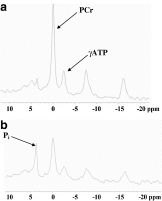Skeletal muscle ATP kinetics are impaired in frail mice
- PMID: 23695949
- PMCID: PMC3889887
- DOI: 10.1007/s11357-013-9540-0
Skeletal muscle ATP kinetics are impaired in frail mice
Abstract
The interleukin-10 knockout mouse (IL10(tm/tm)) has been proposed as a model for human frailty, a geriatric syndrome characterized by skeletal muscle (SM) weakness, because it develops an age-related decline in SM strength compared to control (C57BL/6J) mice. Compromised energy metabolism and energy deprivation appear to play a central role in muscle weakness in metabolic myopathies and muscular dystrophies. Nonetheless, it is not known whether SM energy metabolism is altered in frailty. A combination of in vivo (31)P nuclear magnetic resonance experiments and biochemical assays was used to measure high-energy phosphate concentrations, the rate of ATP synthesis via creatine kinase (CK), the primary energy reserve reaction in SM, as well as the unidirectional rates of ATP synthesis from inorganic phosphate (Pi) in hind limb SM of 92-week-old control (n = 7) and IL10(tm/tm) (n = 6) mice. SM Phosphocreatine (20.2 ± 2.3 vs. 16.8 ± 2.3 μmol/g, control vs. IL10(tm/tm), p < 0.05), ATP flux via CK (5.0 ± 0.9 vs. 3.1 ± 1.1 μmol/g/s, p < 0.01), ATP synthesis from inorganic phosphate (Pi → ATP) (0.58 ± 0.3 vs. 0.26 ± 0.2 μmol/g/s, p < 0.05) and the free energy released from ATP hydrolysis (∆G ∼ATP) were significantly lower and [Pi] (2.8 ± 1.0 vs. 5.3 ± 2.0 μmol/g, control vs. IL10(tm/tm), p < 0.05) markedly higher in IL10(tm/tm) than in control mice. These observations demonstrate that, despite normal in vitro metabolic enzyme activities, in vivo SM ATP kinetics, high-energy phosphate levels and energy release from ATP hydrolysis are reduced and inorganic phosphate is elevated in a murine model of frailty. These observations do not prove, but are consistent with the premise, that energetic abnormalities may contribute metabolically to SM weakness in this geriatric syndrome.
Figures





References
-
- Balaban RS, Koretsky AP. Interpretation of 31P NMR saturation transfer experiments: what you can’t see might confuse you. Focus on "Standard magnetic resonance-based measurements of the Pi–>ATP rate do not index the rate of oxidative phosphorylation in cardiac and skeletal muscles". Am J of Physiol Cell Physiol. 2011;301:C12–15. doi: 10.1152/ajpcell.00100.2011. - DOI - PMC - PubMed
MeSH terms
Substances
Grants and funding
LinkOut - more resources
Full Text Sources
Other Literature Sources
Medical
Research Materials
Miscellaneous
